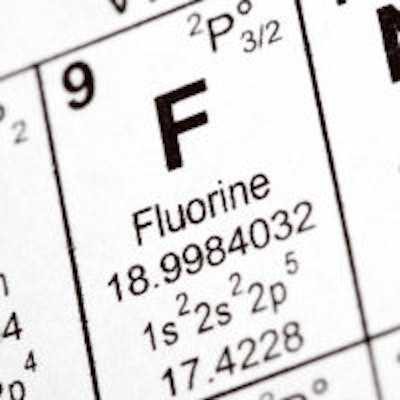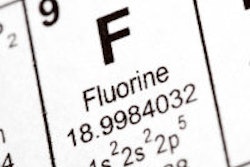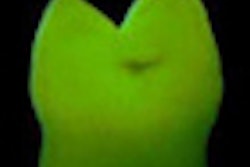
Dental fluorosis may not have a significant impact on the functionality of teeth, but it can be a major issue in patients' minds. The treatment options for nonsevere cases of fluorosis should be both minimally invasive and cost-effective, according to the researchers of a new study.
To help clinicians decide which treatment to employ that fits these criteria, researchers at the Federal University of Paraiba and the Federal University of Pelotas in Brazil compared two options: enamel microabrasion or microabrasion associated with at-home tooth bleaching.
The parallel randomized clinical trial found that both treatment protocols effectively reduced signs of fluorosis. "However, when home bleaching was associated to enamel microabrasion, patients reported a major satisfaction with dental appearance," the researchers wrote in the Journal of Dentistry (January 29, 2014).
Interestingly, these are two of the most conservative approaches to removing fluorosis stains, yet the researchers found a lack of clinical trials of this nature comparing them. Consequently, they sought to "evaluate the acceptability, efficacy, and safety of enamel microabrasion and the association of this technique with at-home tooth bleaching on the removal [of] fluorosis stains," the researchers explained.
They began the study with a calibration session with the study examiners to ensure consistent evaluations of the fluorosis appearance. With the aid of advertisements and health personnel, they found 130 participants. These participants were from a semiarid region that has high amounts of fluoride in its groundwater, and, as a result, fluorosis is common there.
After sharing their medical history and a dental examination, the participants underwent complete dental prophylaxis, removing extrinsic stains. During this process, the researchers began excluding a number of the initial 130 volunteers until 70 participants between the ages of 15 and 39 remained; 22 were male and 48 were female. These participants were then evenly divided between treatment groups at random.
After cleaning, the teeth were dried and pictures were taken with a digital camera to capture baseline enamel staining; an experienced examiner who had undergone the calibration training evaluated these images. Next, the participants were divided into groups based on the severity of their fluorosis and then randomly separated into one of the two treatment groups. Group I underwent enamel microabrasion with 37% phosphoric acid (FGM Dental Products) and a fine-grained pumice (Quimidrol). Group II received microabrasion and Whiteness Perfect (FGM Dental Products), a home-based tooth bleaching treatment with 10% carbamide peroxide.
During the microabrasion step, the clinicians used a microabrasive paste made of equal parts 37% phosphoric acid and pumice. After light abrading at a slow rotation with a contra-angle, the paste was removed and the teeth rinsed. They repeated this procedure 12 times at one to two clinical sessions per patient; 23 patients had two sessions and 12 had one. After the appointment, the microabraded surfaces of the patients' teeth were polished with felt disks. Lastly, after more rinsing and drying, the clinician applied neutral sodium fluoride foam for one minute. Prior to departure, the patient received teeth-cleaning instructions and nonwhitening toothpaste.
In Group II, 22 patients had two clinical sessions of this type and 13 had one. Two days after completing this phase, the clinicians created bleaching tray reservoirs for each participant and gave them two tubes of bleaching gel. Then they were instructed to use the gel in both arches for four hours each evening for two weeks. Upon completion, the researchers used the remaining gel to gauge compliance. Afterward, the patients were told to record tooth sensitivity and gingival irritation on a visual analogue scale (VAS) scale of 1 (no sensitivity) to 5 (severe sensitivity).
One month later, a round of evaluations by the same two blinded examiners who performed the initial evaluations took place. They employed a VAS from 1 (no improvement) to 7 (exceptional improvement/total stain removal). The patients were instructed to use the same scale to evaluate the improvement of their own teeth. All of the participating patients attended the recall session.
While a significant reduction in the stained areas was observed in both groups (p = 0.0001), the researchers did not find a significant difference between the two (p = 0.7). However, the Group II participants were much happier than their counterparts (p = 0.004). In Group I, 54% reported an improvement in appearance from moderate to excellent, while 86% did so in Group II. Meanwhile, the examiners reported this type of improvement in 69% and 74% of Group I and Group II, respectively, but observed no significant differences (p = 0.8). Additionally, they found no statistical difference in reporting of tooth sensitivity (p = 1.0) or gingival irritation (p = 3.0).
It was unclear why the participants reported better results in the bleaching group. "While the examiners were trained to verify the staining reduction area after treatments, without regard to tooth base shade, the participants were providing a much more subjective and possibly broader opinion," the researchers wrote.
Ultimately, they determined that their study findings suggest that the combination of microabrasion and 10% carbamide peroxide is the better of the two treatment options for mild to moderate fluorosis since the bleaching process reduces contrast between the stained and microabraded areas of enamel. Patients were happier with the treatment outcome and reported no additional sensitivity.



















